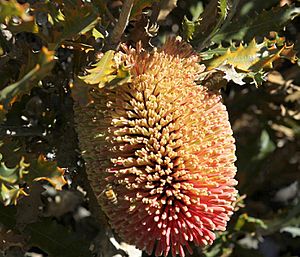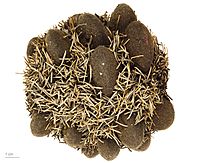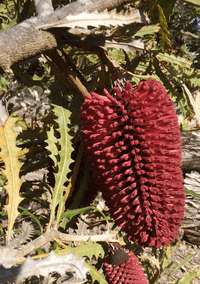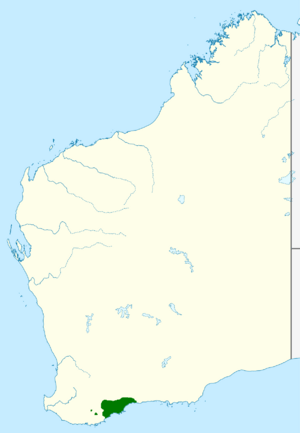Caley's banksia facts for kids
Quick facts for kids Caley's banksia |
|
|---|---|
 |
|
| Scientific classification | |
| Genus: |
Banksia
|
| Species: |
caleyi
|
| Synonyms | |
Sirmuellera caleyi (R.Br.) Kuntze |
|
Banksia caleyi, also known as Caley's banksia or red lantern banksia, is a type of woody shrub. It belongs to the Proteaceae plant family and grows naturally in Western Australia. This plant usually grows as a thick bush, reaching up to 2 meters (7 feet) tall. It has leaves with saw-like edges and red flowers that hang downwards. These flowers are often hidden among the leaves.
The plant was first described in 1830 by a Scottish scientist named Robert Brown. He named it Banksia caleyi to honor an English botanist, George Caley. This banksia is special because its flowers hang down, which is unusual for banksia plants.
You can find Banksia caleyi south and east of the Stirling Ranges, all the way to Jerramungup. It lives in areas that often experience bushfires. When a fire happens, the plants die, but new ones grow from seeds left behind. This species is considered "Not Threatened" in Western Australia. Unlike many other banksias, it can resist a plant disease called dieback. This makes it easier to grow in gardens.
Contents
What Does Caley's Banksia Look Like?
Banksia caleyi grows as a bushy shrub with many branches. It can reach about 2 meters (7 feet) tall. Sometimes, it can even grow up to 4 meters (13 feet) high. Its bark is grey and crumbly. New parts of the plant are hairy and usually grow in summer. The small branches become smooth after about two years.
The leaves are stiff and shaped like a narrow wedge. They are 5 to 14 centimeters (2 to 5.5 inches) long and 1.3 to 2.4 centimeters (0.5 to 1 inch) wide. The edges of the leaves have many small teeth, like a saw. Each tooth is about 0.4 to 0.6 centimeters (0.15 to 0.25 inches) long.
Flowers and Seeds
Banksia caleyi flowers bloom between September and January. The flowers hang down from branches that are three to five years old. They are often hidden deep inside the bush. Each flower cluster is 5 to 9 centimeters (2 to 3.5 inches) long and about 7 centimeters (2.75 inches) wide.
The flowers are creamy white at the bottom and deep pink to red at the top. They are brightest before they fully open and then slowly fade as they get older. After flowering, the clusters turn grey. Up to 25 large, woody seed pods, called follicles, develop. These pods are oval-shaped and covered with fine hair. They can be up to 4 centimeters (1.5 inches) long.
The seeds inside are flat and about 4.3 to 4.7 centimeters (1.7 to 1.85 inches) long. They have a dark brown, wrinkled side and a smooth, black side. A strong, dark brown separator keeps the seeds apart in the pod. Young plants, called seedlings, have special first leaves that are dull green with three veins.
How Caley's Banksia Was Named
Robert Brown officially described Banksia caleyi in 1830. He named it after the English botanist George Caley. The first plant sample used for its description was collected in 1829. It was found near King George Sound on Western Australia's south coast.
Over the years, scientists have studied Banksia caleyi to understand its place among other plants. Different botanists have grouped it in various ways based on its features. However, no different types (subspecies) of Banksia caleyi are recognized today.
Where Caley's Banksia Grows
Banksia caleyi grows along the southern coast of Western Australia. You can find it from South Stirling to the West River and northeast towards Pingrup. Some of these plants live inside Fitzgerald River National Park.
It often grows in large numbers in areas with mallee woodland. It prefers white sand, gravel, and sandy clay soils, usually on flat ground. This area gets about 550 to 600 millimeters (21 to 23 inches) of rain each year. Banksia caleyi is not considered an endangered plant.
How Caley's Banksia Survives
Like many plants in south-west Western Australia, Banksia caleyi is used to bushfires. When a fire occurs, the plants are killed. However, the fire helps release their seeds, allowing new plants to grow. This is how the next generation of plants starts. It takes at least three to four years for new seedlings to flower after a bushfire. If fires happen too often (less than every seven years), they can wipe out groups of these plants.
Banksia caleyi is quite good at resisting a disease called wikt:dieback. This disease is caused by a water mold called Phytophthora cinnamomi. Many other banksia plants in Western Australia are very vulnerable to it.
The upside-down flowers of Banksia caleyi drip nectar onto the ground or lower leaves. This suggests that small mammals that cannot fly, like honey possums, might help pollinate them. The spiky leaves also seem to stop other animals from reaching the flowers from above.
Growing Caley's Banksia in Your Garden
If you want to grow Banksia caleyi, its seeds do not need any special treatment. They usually sprout in 23 to 50 days. This plant grows at a medium-slow pace. It takes about four to five years for a plant grown from seed to produce flowers.
The flowers are pretty, but they are often hidden by the leaves. This banksia can grow in different types of soil, as long as the soil drains water well. It prefers a soil pH between 6 and 7.5. It can grow in full sun or partly shaded spots and can handle light trimming. Unlike many other banksias from Western Australia, Banksia caleyi can grow well in more humid places, like Australia's east coast. It can also attract small possums and honey possums to your garden.





